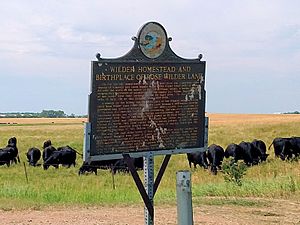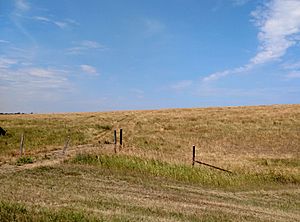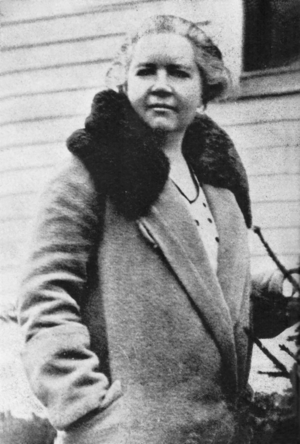Rose Wilder Lane facts for kids
Quick facts for kids
Rose Wilder Lane
|
|
|---|---|
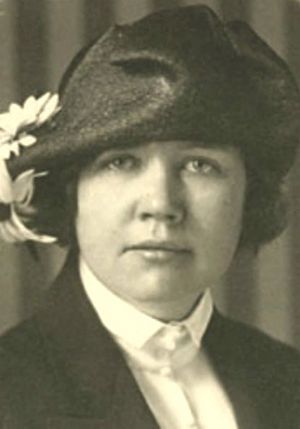 |
|
| Born | December 5, 1886 De Smet, Dakota Territory |
| Died | October 30, 1968 (aged 81) Danbury, Connecticut, U.S. |
| Occupation | Writer, political theorist |
| Nationality | American |
| Period | 1914–1965 |
| Notable works | The Discovery of Freedom |
| Spouse |
Claire Gillette Lane
(m. 1909; div. 1918) |
| Relatives | Laura Ingalls Wilder (mother) Almanzo Wilder (father) |
Rose Wilder Lane (born December 5, 1886 – died October 30, 1968) was an American writer. She wrote for newspapers, traveled a lot, and wrote novels. Rose was the daughter of the famous author Laura Ingalls Wilder. Rose Wilder Lane was also known for her ideas about freedom and individual choice. She was a key person in the American movement called libertarianism, along with writers Ayn Rand and Isabel Paterson.
Contents
Rose's Early Life
Rose was the first child of Laura Ingalls Wilder and Almanzo Wilder. She was their only child who lived to be an adult. Her family faced tough times when she was young. They had problems with crops, illnesses, and money.
During her childhood, the family moved many times. They lived with relatives in Minnesota and Florida. They also briefly returned to De Smet, South Dakota. In 1894, they settled in Mansfield, Missouri. There, her parents started a dairy farm and grew fruit.
Rose went to high school in Mansfield and Crowley, Louisiana. She lived with her aunt Eliza Jane Wilder. Rose graduated in 1904 in a class of seven students. She was very smart and ambitious. She learned three years of Latin in just one year. She also graduated at the top of her class in Crowley. Even with her great grades, she could not go to college. This was because her parents did not have enough money.
Early Career and Marriage
After high school, Rose went back to her parents' home in Mansfield. She learned how to use a telegraph at the Mansfield railroad station. Rose wanted more opportunities than Mansfield offered. By early 1905, she was working for Western Union in Sedalia, Missouri. In 1906, she worked as a telegrapher at the Midland Hotel in Kansas City. For the next five years, Rose worked as a telegrapher in Missouri, Indiana, and California.
In 1908, Rose moved to San Francisco, California. She worked as a telegrapher at the Fairmont Hotel. In March 1909, Rose married Claire Gillette Lane. He was a salesman and sometimes worked for newspapers. They had met in Kansas City. Rose's diary suggests she moved to San Francisco to be with him.
Soon after they married, Rose left her job at Western Union. The couple traveled across the United States. They promoted different business ideas. Rose became pregnant. While in Salt Lake City, she gave birth to a baby boy who did not survive. After this, she likely could not have more children. Rose rarely spoke about this sad event.
For a few years, the Lanes kept moving around. They lived in Missouri, Ohio, New York, and Maine. They worked together and separately on different projects. Rose wrote letters to her parents saying she was happy. But her later diaries showed she felt sad and unhappy with her marriage. She felt her interests did not match her life with her husband.
During these years, Rose read a lot. She taught herself several languages. She knew she had not gone to college. Her writing career started around 1908. She took freelance newspaper jobs to earn extra money. In 1913 and 1914, the Lanes sold farm land near San Jose. Rose was better at selling than her husband. Their marriage had problems, and they often separated. They eventually divorced in a friendly way. Rose never married again. She chose to stay single and free.
World War I made the real estate market weak. So, in early 1915, Rose took a job as an editorial assistant. She worked at the San Francisco Bulletin newspaper. This job changed her career. Her editors quickly noticed her talent. She was a great writer and also a skilled editor for others. Soon, her photo and name were in the Bulletin every day. She wrote romantic stories that ran for weeks. Rose also wrote books about famous people like Henry Ford, Charlie Chaplin, Jack London, and Herbert Hoover.
Later in 1915, Rose's mother visited San Francisco. They went to the Panama–Pacific International Exposition together. Laura Ingalls Wilder's letters to her husband describe this visit. These letters were published in West from Home in 1974. Rose's diaries show she was separated from her husband in 1915. But her mother's letters do not mention this. It seems the separation was kept quiet, or they were still living together.
Becoming a Freelance Writer
By 1918, Rose's marriage was officially over. She also left her job at the San Francisco Bulletin. This is when she started her career as a freelance writer. From this time until the early 1940s, her work appeared in popular magazines. These included Harper's, Saturday Evening Post, and Good Housekeeping. Some of her short stories were nominated for O. Henry Prizes. A few of her novels became bestsellers.
Rose became the first person to write a biography of Herbert Hoover. She wrote The Making of Herbert Hoover in 1920. She worked with Charles K. Field, an editor at Sunset magazine. This book was published before Hoover became president in 1929. Rose was Hoover's friend and supporter for the rest of her life. Many of her personal papers are now at the Herbert Hoover Library in West Branch, Iowa.
In the late 1920s, Rose was one of the highest-paid female writers in America. She was friends with famous people like Sinclair Lewis and Lowell Thomas. But she was very generous with her family and friends. This often left her short on money. She had to work on projects that paid well, even if they didn't interest her. She was becoming more interested in politics and history.
Rose sometimes felt sad and doubted herself. She called it "bipolar disorder." During these times, she found it hard to write her own stories. But she could easily work as a ghostwriter or editor for other writers. In 1928, Rose returned to the United States. She lived on her parents' farm. She was confident in her book sales and stock market investments. She spent a lot of money. She built a new home for her parents on the farm. She also updated the farmhouse for herself and her visiting friends.
Rose sometimes worked as a war correspondent. She started with the American Red Cross after World War I in Europe. She continued with the Red Cross until 1965. At age 78, she reported from Vietnam for Woman's Day magazine. She wanted to give "a woman's point of view." She traveled a lot in Europe and Asia with the Red Cross.
In 1926, Rose, Helen Dore Boylston, and their French maid traveled from France to Albania. They drove a car they named Zenobia. A book about this trip, Travels With Zenobia, was published in 1983. Rose loved Albania. She lived there for long periods in the 1920s. She also spent time in Paris and at her parents' Rocky Ridge Farm in Missouri. She informally adopted a young Albanian boy named Rexh Meta. She said he saved her life on a mountain trip. She later helped him go to Cambridge University. He worked in the Albanian government.
Working with Her Mother
Rose's part in her mother's Little House book series is important. Her parents had invested money with Rose's broker. When the stock market crashed, the Wilders faced hard times. Rose came to the farm when she was 46. She was divorced and had no children. She had little money.
In late 1930, Rose's mother showed her a rough story. It was about her tough pioneer childhood. It was called Pioneer Girl. Rose saw its potential. She started using her connections in the publishing world. But publishers kept rejecting Pioneer Girl. One editor suggested making a children's novel from the beginning of the story.
Laura and Rose worked on this idea. The result was Little House in the Big Woods. Harper and Brothers accepted it in late 1931. It was published in 1932. The book was a success. So, they decided to continue the series. It followed young Laura into her adult life.
The First Four Years was found after Rose died in 1968. Laura had written this story about the first four years of her marriage. It described the struggles of frontier life. But she never planned for it to be published. In 1971, it became the ninth book in the Little House series.
Successful Novels
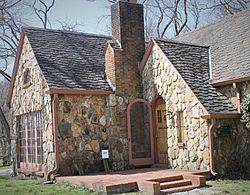
Many historians believe that working together helped both Rose and her mother. Rose wrote her most popular short stories and two most successful novels during this time. She used stories from her mother's memories of the Ingalls-Wilder family.
Let the Hurricane Roar (later called Young Pioneers) and Free Land were about the challenges of homesteading in the Dakotas. This was in the late 1800s. The "free land" actually cost settlers their life savings. The Saturday Evening Post paid Rose a lot of money to publish both novels in parts. They were also made into popular radio shows. These two books were Rose's best creative works. The Saturday Evening Post paid her $30,000 in 1938 for Free Land. That's a lot of money today! Let the Hurricane Roar sold steadily. It became even more popular when Helen Hayes starred in its radio version.
In 1938, Rose used the money from Free Land to pay off all her debts. She moved to Danbury, Connecticut. She bought a country home there with three acres of woods. She lived there for the rest of her life. At the same time, the Little House books were earning more money. This gave Rose's parents a steady income. Rose bought her parents a car. She also paid for the building of the Rock House near the Wilder farm. Her parents lived in the Rock House for much of the 1930s.
Return to Journalism and Views
During World War II, Rose started a new phase in her writing. From 1942 to 1945, she wrote a weekly column. It was for The Pittsburgh Courier, a widely read African-American newspaper.
Rose used this chance to share her ideas about individual freedom. She wrote about topics important to her readers. Her first column said the Double V campaign was part of a bigger fight for freedom in the U.S. She wrote: "Here, at last, is a place where I belong. Here are the Americans who know the value of equality and freedom." Her columns highlighted success stories of black people. She used these stories to show ideas about business, freedom, and creativity.
Rose believed in individual freedom and was against racism. She thought judging people by skin color was wrong. She also believed that groups who supported President Franklin D. Roosevelt's New Deal were wrong. She felt they filled "young minds with fantasies of 'races' and 'classes'."
Rose, along with writers Zora Neale Hurston and Isabel Paterson, did not like Roosevelt's foreign policy. They were against forcing young men to join a foreign war.
The Discovery of Freedom
For a few months in 1940, Rose's interest in libertarianism grew. She connected with John Patric, a writer who shared her political ideas. They traveled across the country in Patric's car. They wanted to see how the Great Depression affected the nation. They also shared ideas. Their trip ended with a two-month stay in Bellingham, Washington.
In the early 1940s, Rose stopped writing commercial fiction. She still worked on her mother's books. At this time, she became known as an important person in the libertarian movement. She strongly opposed the New Deal. She disliked "creeping socialism", Social Security, wartime rationing, and all taxes. Rose stopped writing highly paid stories to protest paying income taxes.
She lived on a small salary from her newspaper column. She no longer needed to support her parents or adopted sons. She cut her spending to the minimum. She lived a simple life on her land near Danbury, like her pioneer ancestors. She got some media attention for refusing a ration card. Instead, she worked with her neighbors to grow food.
Rose was a strong opponent of communism. She had seen it firsthand in the Soviet Union during her Red Cross travels. Her first writings about individual freedom began in the 1930s. This led to her book The Discovery of Freedom (1943). After this, Rose wrote about individual freedom and its effect on people. In the same year, Isabel Paterson's The God of the Machine and Ayn Rand's novel The Fountainhead were also published. Because of these books, these three women are called the founding mothers of the American libertarian movement.
Writer Albert Jay Nock said that Rose and Paterson's books were the only clear books on individual freedom written in America that century. He said they showed the male world how to think deeply. Journalist John Chamberlain said Rand, Paterson, and Rose helped him change his mind from socialism to a more traditional American idea of freedom.
In 1943, Rose became famous for her response to a radio poll about Social Security. She sent a postcard comparing Social Security to a Ponzi scheme. She felt it would destroy the United States. During wartime, mail was watched. A Connecticut State Trooper came to her home to ask about her reasons. Rose strongly reacted to this. She felt it was an attack on her right to speak freely. This led to many newspaper articles and a pamphlet called "What is this, the Gestapo?". It reminded Americans to protect their rights during wartime. The FBI even started a file on Rose during this time.
As Rose got older, her political views became very strong. She was a firm libertarian. Some people found her defense of American freedom harsh when others disagreed. She broke ties with her old friend Isabel Paterson in 1946. Rose also had difficult letters with socialist writer Max Eastman during this time.
Later Years and Death
In the 1940s and 1950s, Rose helped start the libertarian movement. She wrote many letters to people like DuPont executive Jasper Crane and writer Frank Meyer. She also wrote to her friend Ayn Rand. She wrote book reviews for the National Economic Council, Inc. and later for the Volker Fund. This fund helped create the Institute for Humane Studies. Later, she gave talks and money to the Freedom School, led by libertarian Robert LeFevre.
When her mother died in 1957, the Rocky Ridge Farm house went to the farmer who had bought the property. The local people formed a group to buy the house and land for a museum. Rose was unsure at first. But she came to believe that a museum would bring lasting attention to the books. It would also support the idea of individualism she and her mother put into the series. She gave the money to buy the house and make it a museum. She also promised to give money each year for its upkeep. She gave many of the family's belongings to the museum.
Rose inherited money from her mother's Little House book royalties. This allowed her to travel widely again. She also fixed up her Connecticut home. In the 1960s, she started writing for magazines again. She wrote a series about her trip to the Vietnam War zone in late 1965.
In her later years, Rose wrote a book about the history of American needlework for Woman's Day. She edited and published On the Way Home. This book used her mother's 1894 diary about their six-week journey from South Dakota to Missouri. Rose wrote it because fans of the Little House series kept asking "what happened next?". She also reviewed books for the William Volker Fund. She kept working on changes to The Discovery of Freedom, but she never finished it.
Rose was like an adoptive grandmother and mentor to Roger Lea MacBride. He later became the Libertarian Party's candidate for president in 1976. He was the son of one of her editors. Rose said she was preparing him to be a future leader in libertarian ideas. MacBride became her close friend, lawyer, and business manager. After her death, he inherited the Little House series and built a huge business around it.
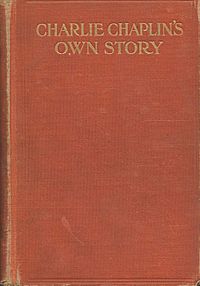
Rose's last student was the sister of her Vietnamese interpreter. Rose was impressed by the young girl's intelligence. She helped bring her to the United States and paid for her college education.
Rose died in her sleep at age 81 on October 30, 1968. She was about to start a three-year world tour. She was buried next to her parents in Mansfield Cemetery, Missouri.
Rose Wilder Lane in Movies and Books
Rose was played in TV shows based on Little House on the Prairie by:
- Jennifer and Michele Steffin
- Terra Allen (part 1) and Skye McCole Bartusiak, Christina Stojanovich (part 2), in the miniseries Beyond the Prairie: The True Story of Laura Ingalls Wilder.
Roger Lea MacBride wrote eight novels about Rose's childhood and early youth. People debate how accurate these books are. But some events may be true since he was her close friend.
In the novel Pioneer Girl by Bich Minh Nguyen, a young Vietnamese-American named Lee Lien studies Rose's life. This is based on an old family story. Lee's grandfather says Rose became friends with his family while visiting Vietnam in 1965. She gave them a gold brooch. People think it might be the one Almanzo gave to Rose's mother in These Happy Golden Years.
In the novel A Wilder Rose by Susan Wittig Albert, Rose tells her story. She talks about working on the Little House books and her years on the Wilder farm (1928–1935). She tells this to Norma Lee Browning, a young friend. The novel uses Rose's diaries, journals, and letters with her mother.
In the alternate history novel The Probability Broach by L. Neil Smith, the United States becomes a libertarian state in 1794. In this story, Rose served as the 21st President of the North American Confederacy from 1940 to 1952.
See also
 In Spanish: Rose Wilder Lane para niños
In Spanish: Rose Wilder Lane para niños


